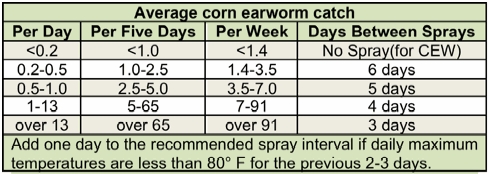This week 17 of the 25 sites reported trap catch counts. Numbers for ECB-E and ECB-Z remain very low with 5 of the 17 sites all reporting 4 or fewer ECB-E moths and only two sites reporting ECB-Z moths. Still no FAW or WBC caught this season. CEW however, is showing a gradual increase with 4 sites reporting catches one as high as 11 moths.
The situation for ECB is the same this week as last. In early sweet corn close to tassel, like that started under row cover, plastic or was transplanted, the usual scouting and threshold recommendations do not apply during the first generation flight of European corn borer (ECB). In these early plantings, larvae don’t feed in the whorl and emerge in the tassel as they do in bare ground corn. For this reason, tassel emergence scouting and thresholds have not been successful in plastic and row cover corn. Growers have had good results when pheromone trap catches were used to time sprays for the first generation ECB in row cover or plastic corn. Growers waited until there was a significant increase in the ECB trap catches in their area and then timed sprays to coincide with egg hatch. ECB eggs require 100 degree days (base 50) from oviposition to hatch. Two to three applications bracketing the peak moth flight are generally effective.
Growers with silking corn near locations where corn earwom are being caught need to consider them when deciding their spray timing. If you are close to a site where CEW are being caught the recommended spray schedule is every 6 days where 1.4 to 3.5 moths are being caught per week, every 4 days where 3.5 to 7 moths are being caught per week, and every 5 days where 7 to 91 moths are being caught per week. CEW require 73 base 55 degree days for eggs to hatch, according to a model developed by Hartstack at College Station, TX. Looking at the forecast for warming weather, eggs will be hatching as few as five days after being laid. To determine the degree day accumulation for your area please visit the NEWA website (http://newa.cornell.edu/). Corn earworm lay their eggs on corn silks (see photo below). After the eggs hatch the larvae move down the silks into the corn ear where they begin to feed. Once the larvae are in the husks, insecticide sprays become ineffective, for this reason it is so important to time sprays prior to egg hatch so that spray residue is present when eggs begin to hatch.
| Location | ECB-E | ECB-Z | CEW | FAW | WBC |
| Avoca (Steuben Co.) | NA | NA | NA | NA | NA |
| Avon (Livingston Co.) | NA | NA | NA | NA | NA |
| Baldwinsville (Onondaga Co.) | 2 | 0 | 0 | 0 | NA |
| Batavia (Genesee Co.) | 0 | 0 | 2 | 0 | 0 |
| Bellona (Yates Co.) | NA | NA | NA | NA | NA |
| Eden Z (Erie Co.) | 0 | 0 | 11 | 0 | 0 |
| Farmington (Ontario Co.) | 1 | 0 | 1 | 0 | 0 |
| Hamlin (Monroe Co.) | 0 | 0 | 0 | 0 | 0 |
| Interlaken (Seneca Co.) | 0 | 0 | 0 | 0 | 0 |
| Kennedy (Chautauqua Co.) | 0 | 0 | 0 | 0 | 0 |
| King Ferry (Cayuga Co.) | NA | NA | NA | NA | NA |
| Kirkville (Madison Co.) | 4 | 0 | 0 | 0 | NA |
| LeRoy (Genesee Co.) | 0 | 1 | 0 | 0 | 0 |
| Lockport (Niagra Co.) | 0 | 0 | 0 | 0 | 0 |
| Olean (Cattaraugus Co.) | NA | NA | NA | NA | NA |
| Oswego (Oswego Co.) | 2 | 0 | 0 | 0 | 0 |
| Owego (Tioga Co.) | 0 | 0 | 0 | 0 | 0 |
| Penn Yan (Yates Co.) | 2 | 2 | 0 | 0 | NA |
| Pike (Wyoming Co.) | NA | NA | NA | NA | NA |
| Plessis (Jefferson Co.) | NA | NA | NA | NA | NA |
| Preble (Cortland Co.) | 0 | 0 | 0 | 0 | 0 |
| Sherwood (Cayuga Co.) | NA | NA | NA | NA | NA |
| Spencerport (Monroe Co.) | 0 | 0 | 0 | 0 | 0 |
| Waterport (Orleans Co.) | 0 | 0 | 0 | 0 | 0 |
| Williamson (Wayne Co.) | 0 | 0 | 4 | 0 | 0 |
| ECB – European Corn Borer CEW – Corn Earworm FAW – Fall Armyworm WBC – Western Bean Cutworm NA – not available |
|||||
| trap catches for the week of 6.11.13 – 6.18.13 |
|||||


